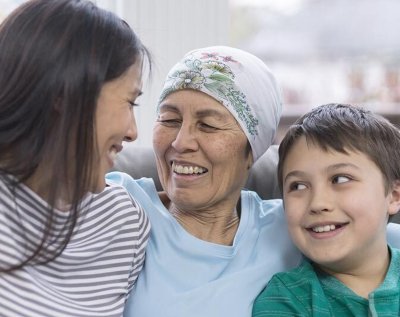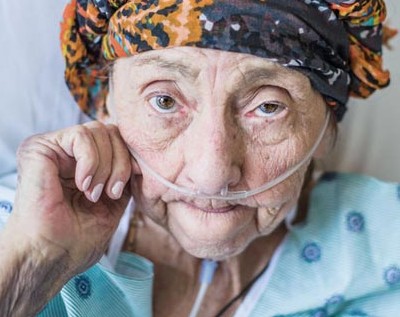Overcoming Barriers to Hospice Care for Advanced Cancer Patients
By Ileana Leyva, MD, Regional Medical Director, VITAS Healthcare
When a patient's advanced cancer no longer responds to curative treatments, they arrive at a critical point in their healthcare journey.
A knowledge gap exists surrounding indicators of poorer prognosis in patients with serious illness, a gap that contributes to missed opportunities for hospice services and significant delays in access for those who are referred to hospice care.
In one study, palliative care (PC) experts correctly projected prognosis for only slightly more than 40% of patients with advanced cancer.1 Previous studies among non-PC clinicians report accuracy rates between 20%-30% in similar patient populations.2,3 When clinicians overestimate survival, patients are substantially less likely to enroll in hospice at all and more likely to enroll too late to benefit from its services.2
Patients and their families might avoid acknowledging the terminal nature of the condition; they may also receive poorer communication from their physicians because of a lack of training in facilitating productive goals-of-care conversations.
These barriers can delay goal-concordant care that improves quality of life near the end of life.
Barriers to Hospice Care Persist for Cancer Patients
Hospice use among patients with advanced cancer is associated with reduced pain intensity, symptom burden, and psychological distress; improved quality of life; decreased usage of non-beneficial aggressive care; and increased likelihood of death in a location of preference (most often at home).7, 8-10Evidence also demonstrates that hospice use decreases the frequency of non-beneficial hospitalization and invasive procedures.7
In addition, a propensity-score-match sample of 1,970 family members of patients with advanced cancer who enrolled in hospice reported better outcomes than their non-hospice counterparts. These outcomes included excellent quality end-of-life care (57% hospice vs. 42% non-hospice), end-of–life wishes were followed a great deal (80% vs. 74%), and death occurred in a patient’s preferred setting (68% vs. 39%).4
Despite these outcomes, research has identified several reasons that palliative and hospice care services may be underutilized by patients with advanced cancer, including:
- Reluctance to acknowledge illness severity5
- Perceived understanding of hospice as relinquishing hope5
- Socio-demographic variables including age, gender, race, particularly for racial minorities (Black, Asian, Pacific Islanders), low socio-economic condition, and rural residence6
- Clinician-related barriers, including difficulties with communication and not being informed about available care choices6
- Clinicians’ challenges in determining patient eligibility for hospice5
Clinicians can help overcome these barriers in several ways:
- Fully communicate the prognosis and disease trajectory.
- Being matter-of-fact about their condition gives the patient the benefit of realistic expectations, allowing for pragmatic planning.
- Set aside time to conduct a goals-of-care conversation.
- Studies show goals of care conversations are associated with improved end-of-life outcomes for the patient and their family, including goal-concordant care for the patient and reduced anxiety and depression for surviving family members.11
- Ensure the end-of-life wishes of patients and families are met by making sure they have time to be heard, while confirming that you understand each concern. Using an approach that empathizes, informs, and seeks to learn about the patient’s healthcare goals often results in the patient working with you to develop their preferred care plan.
- Dedicate adequate time during a visit to focus solely on goals-of-care planning.
- Use silence strategically, giving the patient and family time to process complex emotions.
- Educate the patient and their loved ones about their options.
- Patients and families need to clearly understand the full scope of care options to make informed decisions. No loved one should be left saying, “I wish I had known.”
- Take time to help them understand which options best support the patient’s goals and wishes.
- Listen and speak on their terms.
- A person’s faith background, cultural traditions, religious values, and socioeconomic status can shape their views on end-of-life care. When discussing options, make the conversation more productive by being mindful of the cultural, generational, and personal beliefs involved.
- Be aware of language barriers that can lead patients to feel misled or inadequately treated. Work through these for clarity so patients clearly understand what hospice is and where they receive care.
- Religious and cultural traditions can impact pain management at the end of life. Palliation of pain and symptoms is a top care priority for many patients and families; others view physical suffering as simply a part of life. Consider asking the simple question: “What does comfort mean to you or your loved one?”
- Approach cultural barriers by discerning who makes the life-changing decisions in the family. Pause before providing unsolicited advice.
Why Sooner Is Better for Hospice-Eligible Patients
In most cases, patients with cancer are not referred to hospice until they have only a few days left to live.10 From 2016-2018, nearly 38% of all hospice patients received care for less than two weeks, depriving them of the full advantages of the Medicare Hospice Benefit.12
Early utilization of palliative care is associated with symptom relief, improved mood, reduced depressive symptoms, improved quality of life and survival, overall satisfaction with treatment outcomes, and reduced cost of care.6 The reduction in costs when patients across all disease classes, including cancer, use hospice can be significant. Medicare beneficiaries with cancer who used hospice for 31-60 days had a difference of 6% compared with beneficiaries who did not use hospice. For those cancer patients with longer hospice stays, the difference increased further: 61-90 days 9% less, and 90-180 days 13% less.14
Patients and their loved ones benefit together when early referral guides them to symptom-based care plans and specialized end-of-life services; likewise, they experience less satisfactory outcomes together when such care is delayed.
When Quality of Life Is the Optimal Choice: Referring to Hospice
For hospice-eligible patients, an interdisciplinary team of hospice care experts can provide clinical and psychosocial services to increase a patient’s quality of life by expertly managing their symptoms while they remain in their home or other care setting of choice.
Consider hospice care if your patient with advanced cancer has:
- Progressed through first-line treatment and spends 50% of waking hours in a bed or chair
- An average life expectancy of ≤ 3 months
- Indicated they are no longer interested in pursuing anti-tumor therapies
What Can VITAS Offer Your Patients Living With Advanced Cancer?
To provide quality care to your patients, VITAS offers advanced illness specialists who manage pain and symptoms, including high-acuity care to optimize function and quality of life, along with:
- Care coordination
- Open formulary
- HME and supplies
- 24/7/365 clinical care support
- Complex modalities
- Integrative therapies
- Bereavement services
Check with VITAS to determine your patient’s eligibility. VITAS is available 24/7 for seamless care transitions.
1 Gramling, R., et al. (2019). Palliative care clinician overestimation of survival in advanced cancer: disparities and association with end-of-life care. Journal of Pain and Symptom Management, 57(2), 233-240.
2 Glare, P., et al. (2003). A systematic review of physicians’ survival predictions in terminally ill cancer patients. British Medical Journal, 327(7408), 195.
3 Hui, D. (2015). Prognostication of survival in patients with advanced cancer: predicting the unpredictable? Cancer Control, 22(4), 489-497.
4 Kumar, P., et al. (2017). Family perspectives on hospice care experiences of patients with cancer. Journal of Clinical Oncology, 35(4), 432.
5 Pate MN, Nicolla JM, Friedman, FAP, et al: Hospice Use Among Patients With Cancer: Trends, Barriers, and Future Directions. American Society of Clinical Oncology JCO Oncology Practice. 16 (12): 803-808, 2020.
6 Parajuli, J, Tark, A, et al: Barriers to palliative and hospice care utilization in older adults with cancer: A systemic review. J of Geriatric Oncology. 11: 8-16, 2020.
7 Finnigan-Fox G, Matlock DD, Tate CE, et al: Hospice, she yelped: Examining the quantity and quality of decision support available to patients and families considering hospice. J Pain Symptom Manage 54:916-921.e1, 2017.
8 Wright AA, Zhang B, Ray A, et al: Associations between end-of-life discussions, patient mental health, medical care near death, and caregiver bereavement adjustment. JAMA 300:1665-1673, 2008 22.
9 Trevino KM, Prigerson HG, Shen MJ, et al: Association between advanced cancer patient-caregiver agreement regarding prognosis and hospice enrollment. Cancer 125:3259-3265, 2019.
10 Waldrop DP, Meeker MA, Kutner JS: Is it the difference a day makes? Bereaved caregivers’ perceptions of short hospice enrollment. J Pain Symptom Manage 52:187-195.e1, 2016.
11 Detering, K. M., Hancock, A. D., Reade, M. C., & Silvester, W. (2010). The impact of advance care planning on end of life care in elderly patients: Randomised controlled trial. BMJ, 340(mar23 1), c1345–c1345. https://doi.org/10.1136/bmj.c1345
12 National Hospice and Palliative Care Organization. (2020). NHPCO facts and figures: Hospice Care in America.
13 Wittenberg-Lyles EM, Sanchez-Reilly S. Palliative care for elderly patients with advanced cancer; a long-term intervention for end-of-life care. Patients Educ Couns 2008:71; 351-5.
14 NORC at the University of Chicago. Retrieved from Value_Hospice_in_Medicare.pdf (nhpco.org)

Check Hospice Guidelines
Get diagnosis-specific guidelines in our hospice eligibility reference guide.
Hospice Guidelines by Diagnosis Refer Your Patient
